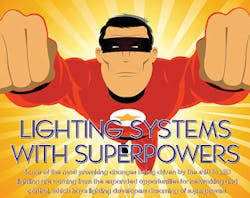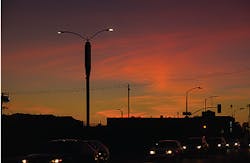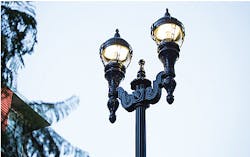As the industry gets comfortable providing more light from semiconductors and less from charged filaments or fluorescent phosphors, the array of benefits this change will bring is beginning to make itself clear — it’s huge, and we’re still very early in the game. Many of those benefits come not from the light source itself but from the controls and the many ways a networked LED lighting system can be put to use.
In strict terms of lighting system applications — i.e., color, brightness, dimmability, responsiveness to changes in the room and other parameters —LED lighting can be controlled in ways legacy lighting technologies could not. By itself this is huge, but beyond the lighting, the communication technologies being designed into new LED systems make it possible to control other devices and systems in what’s come to be called the “Internet of things,” and from there to develop entirely new services and capabilities.
Some interesting examples of new thinking in lighting-system-based controls and networks have come our way recently, and here’s a roundup of some of the highlights we think provide a clue of where such technologies may take the industry. The online version of this story will be packed with links to the products and reports mentioned, and a lot more.
Lighting system as way-finder
Global lighting giant Philips Lighting, Eindhoven, The Netherlands, made some waves last month with the introduction of a system for grocery stores that uses a smart-phone app communicating with intelligent lighting systems to direct shoppers to the products they want to buy. Along the way the system can cue them to specials in the store, suggest recipes and serve advertising for branded products.
Philips started with grocery items, and in most people’s daily lives the supermarket is where they will most often have to search through, select and collect items from aisles of choices. But the technology has obvious applications in other retail settings including discount and department stores, home centers and other big boxes. Can a resurrection of the “blue light special” made famous by Kmart be far off?
Lighting system as food-enhancer
Once the shoppers find the broccoli, you want them to like what they see, and to buy it and take it home. Philips Lighting also thought of that. The company introduced a system designed to enhance the look and preserve the freshness of produce. What Philips calls “light recipes,” or optimized light spectrums, can increase sales by highlighting the freshness of the food on display, the company says. These tuned lights also help to reduce light-induced discoloration of foods such as sliced meat, which can reduce the attractiveness of the products.
Lighting system as mood-enhancer
Lighting Science Group, Satellite Beach, Fla., promotes heavily on the ability of its color-tuned lighting systems to enhance productivity and well-being. LSG calls itself a “provider of biologically-corrected lighting.” For example, some of the company’s lighting technology keys on the ways specific colors of light can affect the body’s circadian rhythms to enhance or suppress melatonin production. Melatonin has been linked to human energy levels and LSG uses light with reduced emphasis on the blue part of the spectrum, called the Good Night Bulb, to induce a restful state at the end of the evening and increased blues, called the Awake & Alert Light, to stir vitality in the morning.
In January this year at the Consumer Electronics Show, LSG introduced the Rhythm Downlight, a lighting system that can be controlled via Bluetooth-linked mobile apps to optimize healthy living and efficient lighting. “The Rhythm Downlight fits in any standard recessed lighting housing and provides dynamic circadian lighting capabilities that automatically adjust the light’s properties to optimize sleep or wakefulness, depending on the users’ needs and schedule,” LSG said in announcing the product.
Lighting system as reminder-minder
It’s already been a year since Philips made a splash in the consumer market with its smart-phone-controlled, wireless Hue system of LED lighting and controls that can use residential lighting to convey information and set color-enhanced moods, a system cited recently in a feature naming Philips among the “Most Innovative Companies in 2014” by FastCompany.
The influence of Hue goes far beyond just that use. With a little imagination and familiarity with the system a user can program a lighting-based reminder to get ready to leave for a dental appointment or to pick up the kids at school. This can be done with dimming, color shift or coordinated changes among multiple fixtures. The Hue system also allows finely detailed color choices — users can pull up an image on their phones, select a pixel with just the right hue, and change the light to match it.
The Hue system is sold exclusively by Apple, but as a proof of concept it’s almost certain to influence lighting systems developed for sale through the traditional electrical supply channel as well. A variety of other “smart bulbs” preceded and followed the Hue into the market. Some of the brands include LIFX, Lumen, RoboSmart and Insteon, as well as giants such as Samsung, TCP and GE.
Lighting system as data router
Lighting on a semiconductor has some unique characteristics, such as being able to flash at a rate the human eye doesn’t notice, on the order of nanoseconds. This capability underlies systems being developed to transmit data via LED lighting, making for optical wireless communications at multi-gigabit rates. Based on a technology called visual light communication (VLC) and often referred to as “Li-Fi”, the systems that do this operate outside the increasingly clogged radio spectrum on which wi-fi systems transmit data, vastly expanding the available bandwidth.
Given the limitation that Li-Fi signals can’t pass through walls, this also serves as a security feature preventing others from capturing the signal. Li-Fi has the further advantage of being able to be used in electromagnetic sensitive areas such as in aircraft cabins, hospitals and nuclear power plants without causing electromagnetic interference.
According to the Li-Fi Consortium, “Li-Fi is a new paradigm for optical wireless technology to provide unprecendented connectivity within a localized data-centric environment. The increasing demand for higher bandwidths, faster and more secure data transmission as well as environmental and undoubtedly human friendly technology heralds the start of a major shift in wireless technology, a shift from RF to optical technologies.”
Lighting system as cell network
Philips added further to the buzz it’s been building around its networked lighting systems last month with a roadway lighting product line developed in partnership with telecom manufacturer Ericsson that integrates small cellular hubs at every light pole. With roadway lighting upgrades one of the hottest areas of the LED lighting market right now, this deal gives cities the added incentive of expanding cellular bandwith at the same time.
GE Lighting, Nela Park, Ohio, in January announced the first big rollout of its LightGrid self-commissioning wireless control system for street lights, which will be installed throughout San Diego, saving the city a reported quarter of a million dollars in energy costs annually while providing GPS location and data-capturing features, allowing for an accurate measurement of performance and energy usage by each individual street light.
When the deal was announced, Todd Gloria, interim mayor, City of San Diego, said, “Light controls are going to be a game changer for the city of San Diego. This innovation will provide us with real-time data on lights that are malfunctioning or not working at all, so communities can feel safe with improved lighting while the historic look of the lights is preserved.”
Lighting system as watchful eye
The intersection of LED lighting with security, location, image capture and big-data analysis represents one of the more far-reaching applications of lighting systems as networks. Last month, LED fixture manufacturer Amerlux, Fairfield, N.J., and Sensity Systems, Sunnyvale, Calif., the manufacturer of Light Sensory Networks (LSNs), announced a new manufacturing partnership. Amerlux will integrate Sensity’s NetSense technology with motion, photonic, energy, and temperature sensors into their exterior LED lighting solutions. This partnership will provide Amerlux customers with a lighting application platform that can generate data to better understand and manage their physical environment for greater productivity, efficiency and security.
“As a result of partnering with Sensity, we are opening up an entirely new area in lighting applications and services for our company that goes far beyond lighting controls by offering an array of third-party applications on our SmartSite LSN products that will include video-based security and public safety, parking management, predictive maintenance and more,” Chuck Campagna, president and CEO of Amerlux, said in a release announcing the deal.
In the future, Amerlux customers with Sensity-enabled LED luminaires will be able to deploy these applications and services to enhance security by extending the security perimeter; provide advanced parking services for both drivers and parking operators; provide retail analytics with data gathered anywhere outdoor lights are placed; and monitor an enterprise or university campus for CO2 emissions, seismic activity, carbon monoxide, pollutants, humidity or UV radiation.
The companies’ system was recently profiled in a New York Times article, “At Newark Airport, the Lights Are On, and They’re Watching You,” which reported that, “Using an array of sensors and eight video cameras around the terminal, the light fixtures are part of a new wireless network that collects and feeds data into software that can spot long lines, recognize license plates and even identify suspicious activity, sending alerts to the appropriate staff.”
Lighting system as lighting system, only moreso
On the more traditional control end a host of advances are being brought to market. Cree, Durham, N.C., last month announced a new wireless lighting control system aimed primarily at the commercial market. For Cree, which has built its presence in lighting from a chip supplier to a luminaire manufacturer, this is the first foray into controls, and the company says its new SmartCast Technology offering is “the first self-programming wireless lighting control system that reduces energy consumption by more than 70% (compared with uncontrolled conventional fluorescents) at half the cost of traditional lighting controls.”
The smart thing about this system is that it removes the configuration and maintenance headaches that come with setting up a new lighting control system. With the touch of a single button, the lighting system’s luminaires detect each other, create their own secure network and group themselves into control zones.
In a recent conversation with a Cree sales rep we learned that the company has committed to an aggressive product development schedule, with internal mandates to introduce at least two major new products every month during 2014.
With innovative uses of lighting controls and lighting systems as data networks launching with what seems increasing frequency, one can only wonder where this will go next. And this article hasn’t even touched on more traditional commercial lighting controls for smart buildings that are likewise in the midst of technological renaissance. It also raises the question of who will sell these systems as they become more common, and how well players in the traditional electrical products supply chain will do at capturing what looks like an explosion of opportunity.
About the Author
Doug Chandler
Senior Staff Writer
Doug has been reporting and writing on the electrical industry for Electrical Wholesaling and Electrical Marketing since 1992 and still finds the industry’s evolution and the characters who inhabit its companies endlessly fascinating. That was true even before e-commerce, LED lighting and distributed generation began to disrupt so many of the electrical industry’s traditional practices.
Doug earned a BA in English Literature from the University of Kansas after spending a few years in KU’s William Allen White School of Journalism, then deciding he absolutely did not want to be a journalist. In the company of his wife, two kids, two dogs and two cats, he spends a lot of time in the garden and the kitchen – growing food, cooking, brewing beer – and helping to run the family coffee shop.



